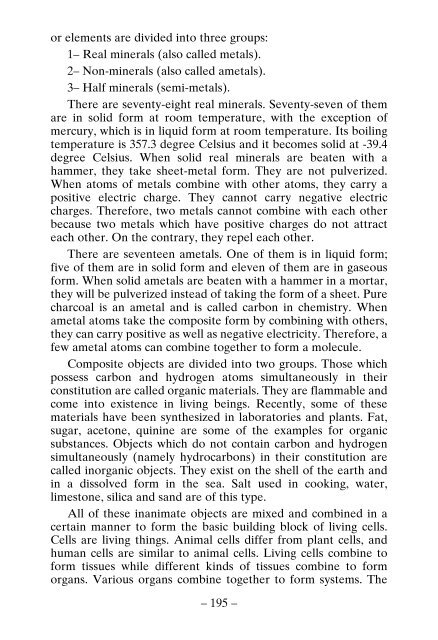Ethics of Islam
Ethics of Islam is taken from the book Berîka by Muhammad Hâdimi. Immorality and ways to get rid of it; 40 depravities and cures to them; usefulness of ethics; what is a soul; strengths of a soul; Personalities emanating from wisdom, courage, chastity and justice are extensively explained.
Ethics of Islam is taken from the book Berîka by Muhammad Hâdimi. Immorality and ways to get rid of it; 40 depravities and cures to them; usefulness of ethics; what is a soul; strengths of a soul; Personalities emanating from wisdom, courage, chastity and justice are extensively explained.
Create successful ePaper yourself
Turn your PDF publications into a flip-book with our unique Google optimized e-Paper software.
or elements are divided into three groups:<br />
1– Real minerals (also called metals).<br />
2– Non-minerals (also called ametals).<br />
3– Half minerals (semi-metals).<br />
There are seventy-eight real minerals. Seventy-seven <strong>of</strong> them<br />
are in solid form at room temperature, with the exception <strong>of</strong><br />
mercury, which is in liquid form at room temperature. Its boiling<br />
temperature is 357.3 degree Celsius and it becomes solid at -39.4<br />
degree Celsius. When solid real minerals are beaten with a<br />
hammer, they take sheet-metal form. They are not pulverized.<br />
When atoms <strong>of</strong> metals combine with other atoms, they carry a<br />
positive electric charge. They cannot carry negative electric<br />
charges. Therefore, two metals cannot combine with each other<br />
because two metals which have positive charges do not attract<br />
each other. On the contrary, they repel each other.<br />
There are seventeen ametals. One <strong>of</strong> them is in liquid form;<br />
five <strong>of</strong> them are in solid form and eleven <strong>of</strong> them are in gaseous<br />
form. When solid ametals are beaten with a hammer in a mortar,<br />
they will be pulverized instead <strong>of</strong> taking the form <strong>of</strong> a sheet. Pure<br />
charcoal is an ametal and is called carbon in chemistry. When<br />
ametal atoms take the composite form by combining with others,<br />
they can carry positive as well as negative electricity. Therefore, a<br />
few ametal atoms can combine together to form a molecule.<br />
Composite objects are divided into two groups. Those which<br />
possess carbon and hydrogen atoms simultaneously in their<br />
constitution are called organic materials. They are flammable and<br />
come into existence in living beings. Recently, some <strong>of</strong> these<br />
materials have been synthesized in laboratories and plants. Fat,<br />
sugar, acetone, quinine are some <strong>of</strong> the examples for organic<br />
substances. Objects which do not contain carbon and hydrogen<br />
simultaneously (namely hydrocarbons) in their constitution are<br />
called inorganic objects. They exist on the shell <strong>of</strong> the earth and<br />
in a dissolved form in the sea. Salt used in cooking, water,<br />
limestone, silica and sand are <strong>of</strong> this type.<br />
All <strong>of</strong> these inanimate objects are mixed and combined in a<br />
certain manner to form the basic building block <strong>of</strong> living cells.<br />
Cells are living things. Animal cells differ from plant cells, and<br />
human cells are similar to animal cells. Living cells combine to<br />
form tissues while different kinds <strong>of</strong> tissues combine to form<br />
organs. Various organs combine together to form systems. The<br />
– 195 –

















